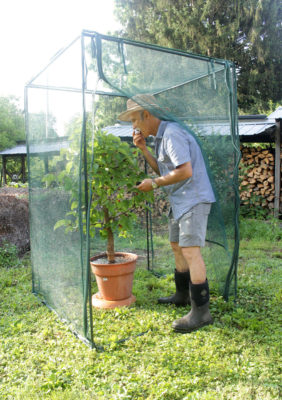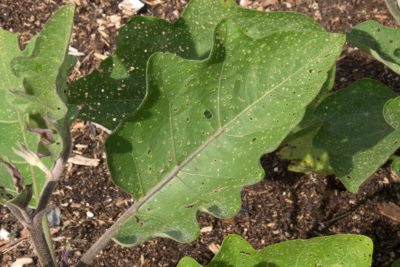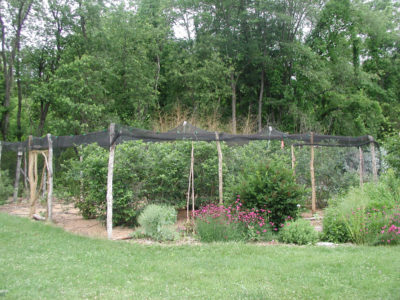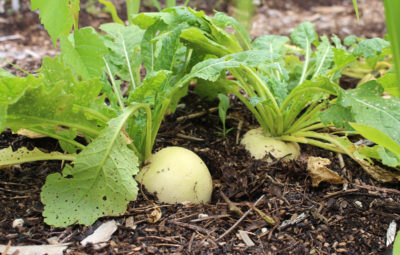GOOD FRUITS, ONE A VEGETABLE
/6 Comments/in Fruit, Gardening, Pests, Vegetables/by Lee ReichWorld’s Best Fruit?
Finally, I reap the fruits of one of my labors. Literally. The fruit is black mulberry, the species, that is Morus nigra, rather than any of the black-colored mulberries that grow all over the place around here. The latter are species and natural hybrids of white and red mulberries (M. alba and M. rubra).
Black mulberry, native to the Mediterranean climate of western Asia, is not cold-hardy below temperatures in the ‘teens (Fahrenheit) so definitely not cold-hardy here. I first tasted it at a fruit conference in Davis, California and it wowed me even from among bowls heaped high with fresh-picked apricots, peaches, and other seasonal fruits.
I had to get a tree to grow, which I did (from www.whitmanfarms.com). The tree went into a pot with potting soil. As it grew, I moved it on into larger and larger pots, stopping at an 18-inch diameter pot. I figured that would be the largest pot I could muscle down the basement steps for cool, winter storage along with my figs and pomegranates.
The tree bore quickly, and the “east coast” black mulberries were delicious, what few of them I harvested. Problem was that birds also found them delicious, a problem compounded by the fact that the berries are not at their best until matte black and ready to be released from the plant at the slightest touch. The birds don’t wait that long.
Dead ripe, the fruits are so soft that they can’t help but stain your fingers. (The stain was once used as a dye, called “murry.”)
A Cagey Solution
My first solution to the bird issue was to plant the mulberry in the ground in my cool (as in temperature cool) greenhouse, which is also home to some in-ground fig trees. Since mulberry seedlings pop up all over the place around here, I just dug up a seedling, grafted onto it a stem from my black mulberry, and planted it in the greenhouse.
Mulberry trees can grow big, bigger than my greenhouse. My plan was to espalier the branches against the west wall of the greenhouse. The espalier worked as far as training the branches in an ornamental candelabra. The birds were kept at bay. The espalier did not work as far as bearing fruit, the reason for which I have no idea why. I dug up the tree.
My original mulberry still grows in a pot and, despite its small stature, still bears good crops of fruit. A few weeks ago I saw advertised a walk-in, temporary cage for protecting plants from birds (available from Gardeners Supply Co.).
The cage arrived just as the first black mulberries were ripening. Within 20 minutes I had the various pole pieces joined to each other and to the corner brackets, and the net attached over the top and sides. At 4 feet by 4 feet and 6 feet high, the cage easily accommodates my mulberry. Even another plant or two.
Every couple of days, now, I unzip the door, enter mulberry paradise, and carefully peruse the plant for dead-ripe berries. I exit with purple-stained fingers. Success.
Eggplant + Oil, A Good Combo
Another success this year has been eggplant. I’ve gardened for many, many years, and for many, many years wasn’t able to grow eggplants well. Beginning gardeners are the ones who usually have greatest success with eggplant. Not exactly beginning gardeners, but beginning gardens.

Flea beetles love to eat eggplant (leaves). They pock the leaves with enough small holes so that only vigorously growing plants survive. But flea beetles rarely show up in a garden in its first year but by the second year they descend in hoards. Hence the successes of beginning gardeners in their beginning gardens.
This year I tried controlling the beetles by spraying the plants weekly with “horticultural oil,” also called “summer oil,” which is a more refined and lighter version of “dormant oil.” I was mixing it up anyway to keep scale insects at bay on the greenhouse figs (more on that some other time). Long story short: The plants are only slight hole-y and I have a fine crop of eggplants on the way.
TWO DELICIOUS ORBS, ONE BLUE & ONE WHITE
/2 Comments/in Fruit, Gardening, Vegetables/by Lee ReichSoil is Key
Last week I described my foray into the New Jersey Pine Barrens, culminating in a visit to the USDA research station there to experience many new, interesting, and tasty varieties of blueberry. The soils of the Pine Barrens, as I wrote provide ideal conditions for the rather specific and unique requirements of this fruit.
That’s not to say that blueberries can’t be grown successfully beyond the Pine Barrens. In fact, they can be grown just about everywhere — if the right varieties are chosen and the soil is amended to suit the plants. The soil here at my farmden, for instance, is very different from that of the Pine Barrens. Mine is a naturally rich silt loam that is slightly acidic; the Pine Barrens are naturally poor sands that are very acidic.
Both soils are well-drained, which is the first requirement for a blueberry soil. The way to make soils that are less than perfectly drained suitable is to plant the bushes atop mounds or carry water away in ditches or in buried, perforated pipes.
Next, acidity. The pH for blueberries needs to be between 4 and 5.5, which is very acidic (and is what blueberry relatives such as rhododendrons and mountain laurels also demand). I acidifed my soil with elemental sulfur, a naturally mined mineral, before planting and do so periodically over the years, as needed. Many gardeners pile oak leaves or pine needles on their ground, or dig these materials into soil, to make a soil more acidic — that doesn’t do the trick; sulfur is what’s needed, 3/4 to 2 pounds per hundred square feet for sandy and clay soils, respectively, for each unit of pH change needed.
Blueberries like their roots coursing through soils that are high in organic materials, not rich organic materials such as manure or compost, though. Peat moss is good; I mixed a bucket full of peat with the soil in each planting hole when I planted. To maintain, even increase, levels of organic matter over the years, the ground beneath my bushes, every year, gets blanketed with a 3 inch depth of some weed-free organic material, such as autumn leaves, wood chips, wood shavings, sawdust, pine needles . . . whatever I can get my hands on.
And finally, blueberries need water, especially when young. That initial dose of peat moss along with yearly, organic mulches, helps the soil hold moisture (in addition to many other benefits).
Oh, one more thing: Ninety percent of blueberry roots are in the top 6 inches of soil. Hence their need for moisture. Those shallow roots also compete poorly with weeds. My 900 square foot of 16 blueberry plants is, essentially, a “no weed” zone, thanks to the mulch and occasional weeding.
Tastiest Turnips
Pushing open the gate to exit the blueberry planting, I walk over and pull open the gate to the vegetable garden. There lies a beautiful (to me) row of sweet, succulent turnips. Not just any old turnip, but the variety Hakurei, the best (to me, and many others gardeners and farmers).
Turnips are an underrated vegetable, perhaps because most that you can buy just don’t taste that good and because most that are grown in home gardens are not the best-flavored. The highest praise I know of for turnips is in the novel Tobacco Road, when Lov Bensey walks seven and a half miles to get a sack of winter turnips for fifty cents, which is half of his daily wage. (Admittedly, he was starving.)
So here’s at least the second written accolade for the turnip. When a good variety is planted and it is well grown, it is a sweet, flavorful vegetable excellent raw, pickled, or cooked. The variety to grow is Hakurei and the way to grow them is in rich, well-drained soil with a steady supply of moisture, the latter of which mine get automatically via drip irrigation.

Hakurei turnip
In the past I planted turnips only in late summer for a crop that ripened during the cool weather of autumn. This year I planted an early crop in the greenhouse; that crop was harvested and eaten by mid-June. I had plenty of seed and space in later in spring, so I planted some outdoors then. We’re still harvesting that crop and, despite the hot days, the flavor is excellent. (Cool nights might be helping to maintain flavor.)
Sometime in the next two weeks, I plan to sow seeds for fall harvest. Last year, that crop, harvested before the weather turned too bitterly cold and the soil froze, went into wooden boxes for cold storage, first just sitting outdoors, then carried into the garage, and, finally, carried down to the cool basement. The last of them, still tasty, were eaten March.


